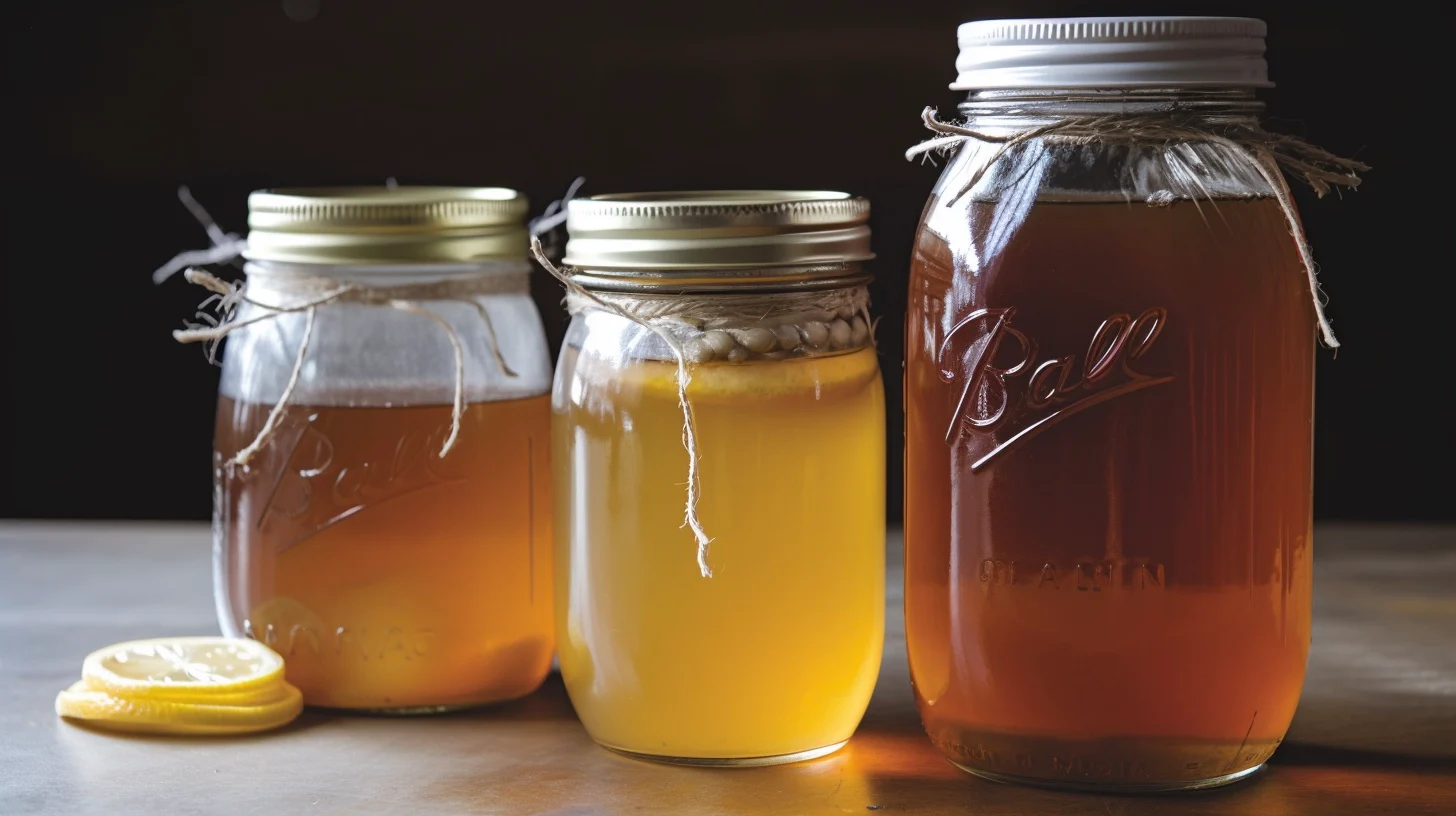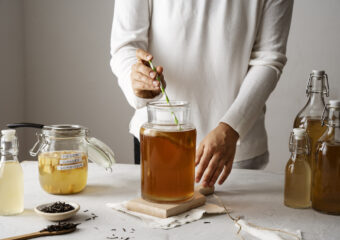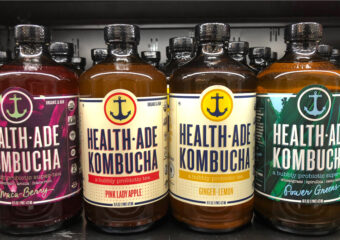Master The Art Of Second Fermentation To Enhance The Flavor Of Your Kombucha
When making kombucha at home, the first fermentation is just the beginning. To truly unlock the refreshing and flavorful potential of your brew, you need to master the second fermentation. This additional step allows you to infuse your kombucha with a burst of new flavors and fizz, making each sip a delightful experience.
Second fermentation depends on the flavors you choose to add to your kombucha. From fruity to spicy, the options are endless. Some popular flavorings include szechuan pods, green tea seeds, and even purple pulp. Experiment with different combinations to find the right mix for your palate.
To start the second fermentation process, make sure your kombucha is fully brewed and reserved in a sealed vessel. Then, move the brew to smaller swing-top bottles, leaving some space at the top for expansion. Add your chosen flavorings using a funnel: fill the bottle with kombucha, leaving a little room at the top for fizz.
Seal the bottles tightly and store them in a cool place to continue the fermentation process. After a day or two, depending on your climate, your kombucha will be ready to enjoy. Burp the bottles occasionally to release excess pressure and prevent explosions.
When the kombucha has reached the ideal flavor and fizz, move the bottles to the refrigerator to chill. This will help slow down the fermentation process and spark a sparkling finish. Once chilled, your kombucha is ready to drink.
Unlock the full flavor potential of your kombucha with second fermentation. Experiment with different flavor combinations and find what works best for you. With consistent practice and a little creativity, you’ll be making delicious, fizzy brews in no time.
Discover the Process
When it comes to spiced kombucha, the fun is in the process. Here’s how to make sure you’re going to enjoy the end result:
- First, make sure you have a fine-mesh funnel and a total of fermented, unpasteurized kombucha ready.
- Next, poppy in extra brewing fruits, such as dark purple berries or lemon slices, to enhance the flavor.
- When bottling your kombucha, you might judge the risk of losing some fruits or chunks along the way, especially in the winter months when it takes longer to ferment.
- To ensure your kombucha is slightly carbonated, seal each bottle tightly and leave it to ferment in a dark place for a few days.
- If you’re feeling adventurous, try adding turmeric or hibiscus puree to the mixture for a unique twist.
- Remember, the longer you leave your kombucha to ferment, the more carbonated and flavorful it will become.
By following these steps and experimenting with different flavors and fruits, you’ll soon be brewing delicious and sparkling kombucha that’s sure to impress even the most reserved of drinkers.
Enhance Your Brew
When it comes to enhancing the flavor of your kombucha, the possibilities are endless. One popular method is to add fruited blends to the brew, which can give it a sweet and sparkling taste. You can also experiment with different fruit purees, such as agave, to create unique and delicious combinations. Another option is to use fresh herbs like basil to add a subtle yet refreshing flavor to your brew.
For those who prefer a darker and more intense flavor, try adding diced matchsticks of purple cabbage or beetroot to your kombucha. Not only will this give your brew a beautiful color, but it will also affect the overall taste, making it more complex and interesting.
If you’re looking to make your kombucha more carbonated, there are a few tricks you can try. One method is to seal your kombucha in glass pods and let it sit for a few days to allow the carbonation to develop. Another option is to blend the remaining pulp from your kombucha with some fruit juice and put it back into the fermenting batch for a few more days. This will help trap more carbonation within your brew, resulting in a more effervescent final product.
Whatever method you choose, remember that the flavor of your kombucha will continue to develop in the refrigerator, so be sure to taste it regularly to see how it’s progressing. And always make sure to read up on the tips and tricks for fermenting in your specific climate – different temperatures and humidity levels can have a big impact on the final flavor of your brew. With a little experimentation and patience, you can create some amazing kombucha blends that are sure to impress.
Creating the Best-Flavored Kombucha: The Process of Pureeing Fruit
One of the essential steps in crafting a refreshing and delicious batch of kombucha is adding fruit puree during the second fermentation. This process not only adds additional flavor but also creates natural carbonation, giving your brew that satisfying fizz.
When choosing the fruit for your flavored kombucha, consider using a variety of options such as berries, oranges, or exotic fruits like mango or papaya. To make the puree, simply wash and purée the fruit of your choice in a blender until it is smooth and slightly chunky. Strain the purée to remove any pulp, seeds, or unwanted chunks, leaving you with a smooth and flavorful fruit base.
| Next, add the strained fruit puree to your kombucha after it has undergone the initial brewing process and has been tightly sealed in bottles for a few days. The sugars in the fruit will kickstart the fermentation process, leading to over-carbonation if left unchecked. |
| To avoid over-carbonation, burp the bottles every few days by opening them slightly to release trapped gases. This will ensure that your kombucha does not become too fizzy and cause a mess when opened. |
Spicing It Up
If you’re feeling adventurous, you can also add spices like cinnamon, nutmeg, or ginger to your fruit puree for a spiced kick. These additions can transform your kombucha into a flavorful and unique drink that is perfect for any occasion.
Adding Flavors to Your Kombucha
One of the best things about brewing your own kombucha is the ability to add delicious flavors to it. By adding fruits, herbs, spices, and other flavorings, you can create a wide range of flavored kombuchas that suit your taste preferences.
Here’s how you can flavor your kombucha during the second fermentation:
| 1. Prepare Your Flavorings |
| 2. Strain out the kombucha mother and pour the plain kombucha into a separate vessel. |
| 3. Add your preferred flavorings into the vessel. This can range from fruits like lemon, berries, or mango to herbs like mint or basil. |
| 4. Seal the vessel, making sure it’s airtight to prevent any bacteria spilling in. |
| 5. Store the vessel in a cooler place, like the fridge, and let the kombucha infuse with the flavors for a few days. |
| 6. After a few days, taste the kombucha to judge the flavor. You can continue to let it infuse for longer if you want a stronger taste. |
| 7. When you’re happy with the flavor, strain out any pulp or seeds and bottle the kombucha. Make sure the bottles are taut and sealed to retain carbonation. |
| 8. You might want to burp the bottled kombucha every day or so to release any over-carbonation buildup. |
| 9. Store the bottled kombucha in the fridge to chill it and slow down fermentation. This will create a bubbly, flavorful drink. |






